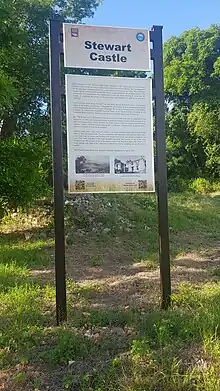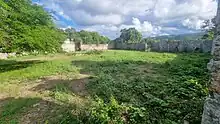
Jamaica National Heritage Trust information board at the site of Stewart Castle.
Stewart Castle was a sugar plantation in Trelawney, Jamaica.[1]
It was established in 1754 by local planter James Stewart.[2] It was inherited by his son, known as James Stewart II, who mortgaged the estate in 1799. The estate was 1,230 acres in extent, of which nearly 500 were planted with sugar cane.[3]

A view of the armoured courtyard of Stewart Castle.
The property was gifted to the Jamaica National Trust Commission, the predecessor to the Jamaica National Heritage Trust (JNHT), in 1960, by the Kaiser Bauxite Company.[4] In 2007, there were archaeological excavations at the site carried out by the Digital Archaeological Archive of Comparative Slavery (DAACS).[5] In 2010, the JNHT considered a proposal to aesthetically develop the site.[4]
References
- ↑ Galle, Jillian. "Stewart Castle Main House". www.daacs.org. Digital Archaeological Archive of Comparative Slavery. Retrieved 7 February 2022.
- ↑ Bates, Lynsey Ann (2015). Surplus and Access: Provisioning and Mark visioning and Market Participation b ticipation by Enslaved Laborers on Jamaican Sugar Estates. University of Pennsylvania.
- ↑ Bates, Lynsey. A GIS-based analysis of plantation spatial organization: Stewart Castle, Jamaica (PDF). Monticello: Monticello Department of Archaeology.
- 1 2 "Stewart Castle Development Proposal" (PDF). Jamaica National Heritage Trust. August 2010. Retrieved 5 January 2024.
- ↑ Galle, Jillian (2007). "Stewart Castle Main House: Background". DAACS. Retrieved 5 January 2024.
This article is issued from Wikipedia. The text is licensed under Creative Commons - Attribution - Sharealike. Additional terms may apply for the media files.